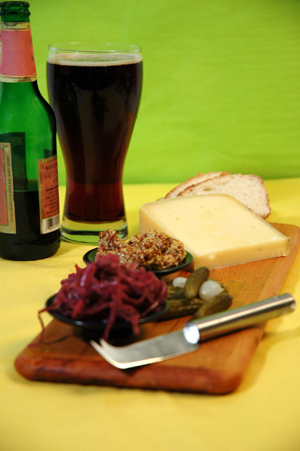

The Cheese
Appenzeller, or Appenzell, is a washed rind cheese produced in the eastern Swiss canton of the same name, bordering Austria and Germany. It is produced in wheels of approximately 15 pounds and is aged about 3 months. Like most premium alpine cheeses, it is made from raw milk, in this case, whole milk.
The wash used for this cheese was once a closely guarded secret, but is now known to contain white wine (or hard cider), herbs, black pepper and brine. This wash creates the characteristically full, fruity aromas and flavors for which this cheese is so famous. As with all cheeses, and washed rind cheeses in particular, the flavors and aromas evolve as the cheese ages. Appenzeller is best when consumed young or medium aged. While there is no such thing in the market as Appenzeller that is too young, there are plenty of examples of Appenzeller that is too old! The rind should be light brown and not cracked (too dry) or slimy (too wet), and the body of the cheese should be creamy ivory, never grayish or brownish. When in good shape, this cheese is delightful as a table cheese or in any dish calling for good melting properties. It is a great addition to traditional fondue.
The Beer
Bock is a beer with a long and somewhat twisted history. There is no doubt that the original Bock beers were developed in the northern German town of Einbeck, a member of the Hanseatic League. The popularity of this rich, malty beer (originally called Einbeck or Ainbock) quickly spread throughout Northern Europe from Russia to the Netherlands and beyond to France and the entire Holy Roman Empire. The Bavarians were not yet the paramount brewers they are today, and this new beer sensation cut into not only their profits, but their pride. They tried many ways to copy the new style, but ultimately had to kidnap the chief brewer from Einbeck in 1612 in order to discover his secrets.
The word Munich translates to “place of the monks,” and much great beer was born in the monasteries of that city. During the fasting periods of Lent and Advent, the monks where prohibited from eating solid foods. They developed extremely malty, filling beers to help them get through the fasts. When the first of these powerhouse beers was released to the public in the late 1700’s it was dubbed Doppelbock (double bock). While it is not truly twice as powerful as the traditional bock, it is certainly more intense. Doppelbock has the most intense, malty flavor of any beer, containing just enough hops to keep it from becoming cloyingly sweet. Look for the original Doppelbock, Paulaner Salvator, or Späten Optimator from Germany, or Gordon Biersch Winterbock from the U.S. “Bock” is German for “goat” and you will often see a goat on the label of imported bock and Doppelbock beers.
The Extras
As with most beer and cheese pairs, these two work wonderfully with pickled veggies. I like to use cornichons and rotkohl (red cabbage) with sourdough rye, speck (a German dry-cured ham similar to prosciutto) and whole grain mustard.
Why it Works
Cheese and beer grew up together on the farms of Europe. Washed rind cheeses are so powerful they require a correspondingly powerful beverage (but not an acidic one), as well as bold accompaniments. Doppelbock, with its intense malty flavors is ideal for this job. Pair it with the sour pickle, the slightly sweet pickled red cabbage, the salty meat and the tangy mustard, and let the fun begin!


